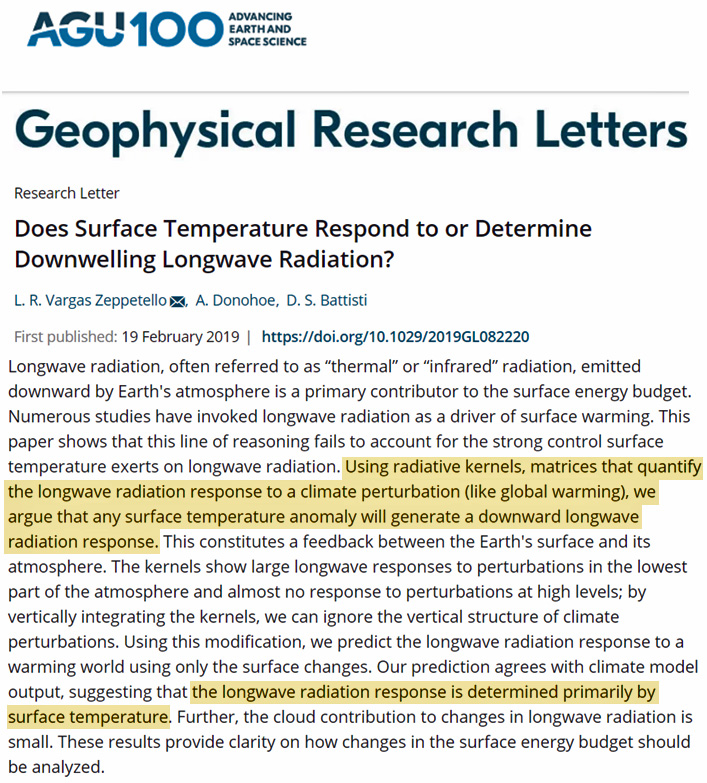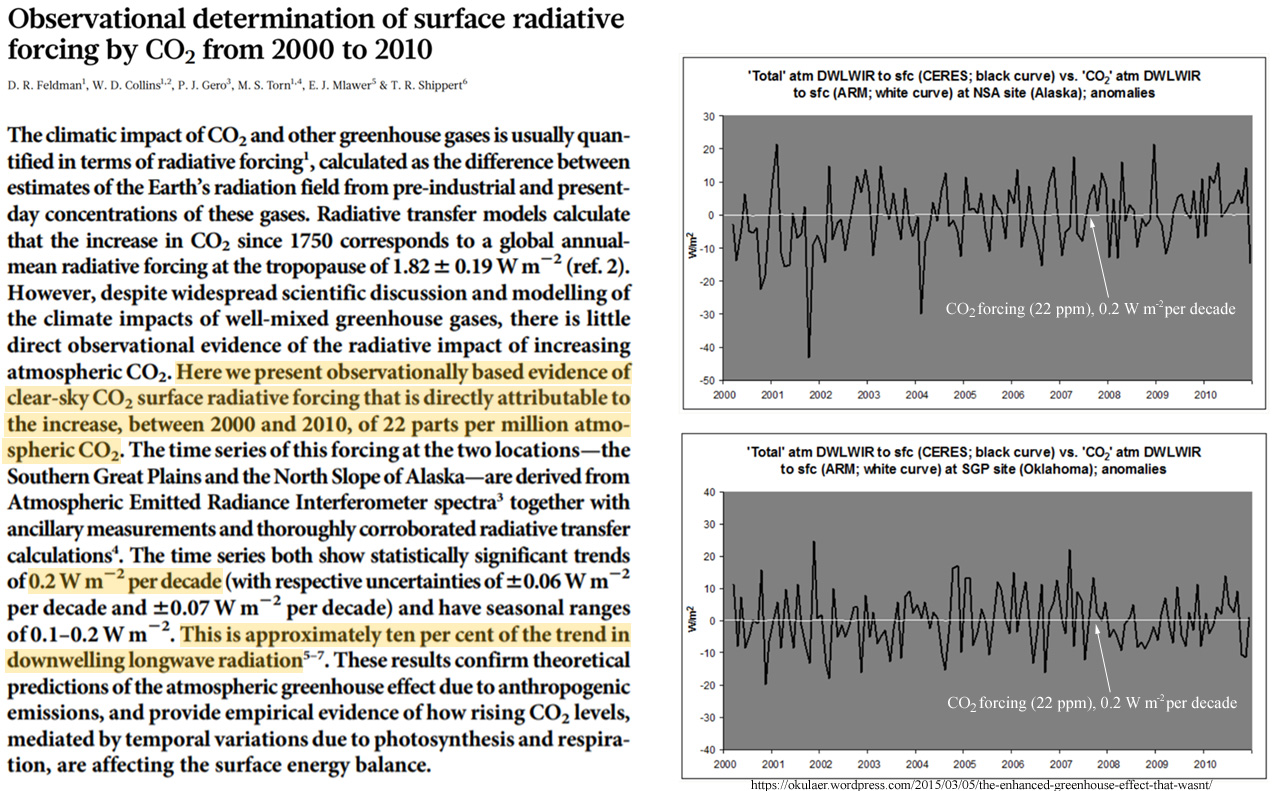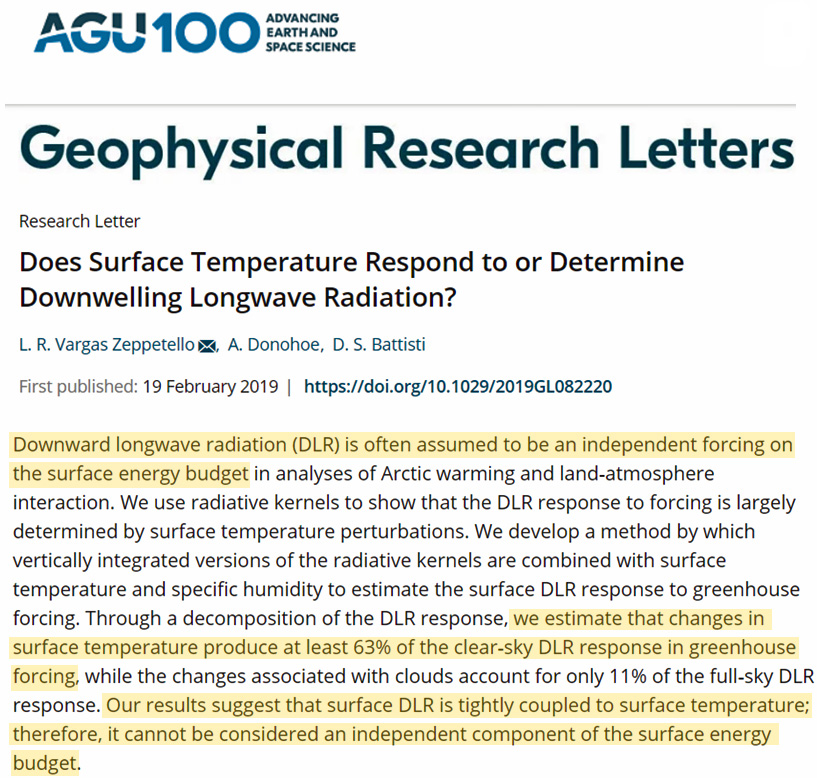The CO2 greenhouse effect presumably perturbs the Earth’s energy budget by driving trends in downwelling longwave radiation from the top of the atmosphere, which in turn drives changes in surface temperatures. Two scientists (Zeppetello and Battisti, 2019) have observed the opposite: perturbations in surface temperatures are what drive changes in downwelling longwave. Consequently, they conclude downwelling longwave “cannot be considered an independent component of the surface energy budget.”

The anthropogenic global warming (AGW) hypothesis rides on the fundamental assumption that perturbations in the Earth’s energy budget – driven by changes in downwelling longwave radiation from CO2 at the top of the atmosphere (TOA) – are what cause climate change.
According to one of the most frequently referenced papers advancing the position that CO2 concentration changes (and downwelling longwave radiation perturbations) drive surface temperature changes, Feldman et al. (2015) concluded there was a modest 0.2 Wm-2 per decade forcing associated with a CO2 change of 22 ppm during 2000 to 2010.
Importantly, this contribution from CO2 accounts for just 10% of the overall trend in downwelling longwave radiation believed to cause global warming.

Image Source: Feldman et al., 2015, Okulaer, 2015
In a new paper, scientists Zeppetello and Battisti, 2019 have found the assumption that “downward longwave radiation” (DLR) forcing independently causes changes to the Earth’s energy budget – and thus drives surface temperature changes – has it exactly backwards.
The DLR perturbations at the TOA are considered primarily a response to surface temperature changes. Concisely, temperature changes drive downwelling longwave, not the other way around.

When we consider CO2 concentration changes may represent just 10% of the overall contribution to downwelling longwave, and that downwelling longwave changes are a response to temperature changes, this would appear to leave little room for CO2 concentration changes to play more than a bit role in climate forcing.





https://climate.nasa.gov/blog/267/
“Robert Byrne, who was an interesting combination of author and billiards champion, once said “Everything is in a state of flux,” and he was right. Our planet is constantly changing — just think about the weather, the seasons, day and night, the tides, volcanoes, earthquakes, ice ages and periods of warming and cooling — as a result of both natural and man-made effects. Sometimes nothing tracks these changes better than a picture or two.”
https://www.weather.gov/lmk/december_1917_january_1918
“December 1917 through January 1918 still stands today as the coldest and snowiest December-January period ever recorded in Louisville, Lexington, Bowling Green, and several other locations across southern Indiana and central Kentucky. The 49 inches of snow that buried Louisville during those two months beats the 2nd snowiest December-January by more than a foot and a half!”
“Concisely, temperature changes drive downwelling longwave [radiation], not the other way around.”
Sounds better than the standard nonsense.
However this modeled exercise has next to show how this can be verified by observation of our dynamic climate system, and show how this impacts on the regions of the globe — the places where weather and climate changes happen.
So it appears to be a step in the right direction but as long as atmospheric moisture, clouds, precipitation, ice, etc., are so poorly represented in Climate Models they will keep missing the mark.
Where does water vapor, which constitutes about 95% of all “greenhouse gasses” (CO2 only about 4%) fit into this setting? I have to believe, based on the paper’s conclusions, that it is similarly affected.
As a side point, human emissions of CO2 constitute only about 3.4% of the 4% total, so we really don’t have any kind of meaningful anthropogenic effect. AOC and others speeches are much ado about nothing…
WV distribution is quite temperature-dependent. There’s ~40,000 ppm in the tropics but <1,000 ppm at the poles. The latter figure is why it's believed CO2 dominates forcing at the poles.
it is the most important greenhouse gas and has magical properties-
https://i0.wp.com/principia-scientific.org/wp-content/uploads/2017/11/vapor.jpg?resize=1024%2C268&ssl=1
Doesn’t this finding match with CO2 in the atmosphere increases BECAUSE THE PLANET IS WARMING (or was warming, until recently)?
Simplified Science: The sun’s rays penetrate the transparent (to sunlight) atmosphere and strike the surface, warming it. The surface radiates in the infrared, to which the atmosphere is opaque due to water vapor, so that the water vapor absorbs the IR from the surface, warming the air it contains, which expands and becomes buoyant and rises to the altitude where the atmosphere becomes transparent to emissions from the water vapor, which then radiates to space. Near the surface, in the shallow layer where the IR from the surface is absorbed (about 10 meters), it really doesn’t matter whether water vapor or CO2 is doing the absorbing, the effect is the same, to generate buoyant lift in the air allowing convective columns to form, which freight train the heat to the radiating zone. I doubt whether any effect from CO2 will ever be detectable. Caveat: CO2 does cause cooling in the mesosphere and the far polar regions.
Simplified Climate: The sun’s rays penetrate the transparent (to sunlight) atmosphere and strike the surface, it’s mostly water. The water warms and some vaporizes to the atmosphere. This water vapor moves solar energy mostly from the tropics to the poles, shedding heat energy to space as it goes. Whatever warm water does not get vaporized immediately, travels around via the ocean currents, and eventually (from a year or two, to tens or even hundreds of years later) gets to try again at vaporizing.
The disparity in temperature between the tropics and the poles is what drives our weather patterns (the where and how fast the humid air moves)and eventually set the short term (70 years or less) climatic conditions.
This evaporative cooling method ensures the planet can never overheat, can never be ‘in heat crisis’ regardless how much of an atmospherically rare gas like CO2 attempts (and fails) to interfere with it. The water cycle is the planet’s thermostatic mechanism, it cools very effectively but warms the planet poorly, hence, in this planet’s history, there’s a higher preponderance of cool/cold periods compared to warm periods (see http://www.climate4you.com/images/VostokTemp0-420000%20BP.gif ).
Agree completely. Evaporative cooling and subsequent precipitation adds “punch” to convection, becoming the major negative feedback on temperature change.
In the CAGW’s unproven infrared-resonant-gas hypothesis, transient radiant energy emitted from the surface is re-emitted from altitude, to be half re-absorbed by the surface, then re-emitted and the half’s half re-absorbed and re-emitted again and again, ad infinitum until doubled, causing the doubling of a warming effect. All that is missing from the schematic is a fat loop that connects up-welling radiant energy for sending it back down like an obedient flock of sheep. The notion of “down-welling” radiation from the upper troposphere to the Earth’s surface, although enshrined as a “given,” an article of scientific sophistication, is no more a possibility than radiation flowing from any direction without an initiating source of energy or being anywhere except in an electromagnetic field gradient from higher to lower energy.
That photons may be “collected” and marshaled for use as and where fits a prescribed result thoroughly misses the nature of gauge bosons as other than discrete signals that track and help define an identifiable physical force. Photons far more resemble impulses picked out by a cardiac monitor than chips in a poker tournament. When the underlying radiant force stops or dissipates, they go away. In the absence of a sufficient power source (such as solar irradiance — already accounted for), down-welling photons from the upper atmosphere’s cooler plane are unlikely to exist at all, much less be incident on, or approach, the higher energy, higher power-density plane of radiant energy on the Earth’s surface. Lower energy photons anywhere above the surface cannot possibly create an “additive” thermal environment to raise temperature. Just as critically, it is worth recalling that surface emissivity/absorptivity is a function not only of the surface material but of whether surface temperature is changing, and the Earth’s surface changes temperature locally all the time. Rather than delve into the numbers in the standard schematics (which have already been sifted innumerable times to no useful effect), it may be more profitable to consider the subject matter freshly in a way seldom if ever before considered or mentioned — within the limitations of standard, tested thermodynamics.
There are several red flags, one of the most disturbing being this…
”Our prediction agrees with climate model output,…”
But since we know the models are not just wrong, but very wrong, how is it that this agreement helps his hypothesis?
Also, this paper just seems like a convoluted way of invoking the warmist fantasy of CO2 back-radiation positive feedback.
Last but not least, they assert that clouds act as ”nearly perfect black bodies.” (P.8, here)
https://pdfs.semanticscholar.org/7fa4/2695015ac4604246fdbc5d991ec3eb08a870.pdf
Eh, no. (Well, at least one of them is wrong.)
”Mean cloud effective emissivity values for the surface to 300 mb layer ranged from 0.41 to 0.64 for the midlatitude data and from 0.54 to 0.84 for the tropical data.”
https://journals.ametsoc.org/doi/abs/10.1175/1520-0469%281976%29033%3C0287%3AOOCIEE%3E2.0.CO%3B2
=======================
And I’ll just toss in this antidote to whatever warmist nonsense for which it may apply.
https://objectivistindividualist.blogspot.com/2011/01/evaluating-catastrophic-man-made-global.html?m=1
Oh, right. There’s also this gem…
”These results confirm theoretical predictions of the atmospheric greenhouse effect due to anthropogenic emissions,…”
It’s still an assumption that the elevated [CO2] is, in fact, anthropogenic. Salby and others do a solid job of showing that it probably isn’t.
Color me unconvinced by Feldman, and Zeppetello.
Yonason,
You dig a bit further than I, and yes you are correct.
IMO it’s just more modeling mirth for morose modelers. 🙂
Call me when observations match the theory.
Just one thing left to check. (Meant to earlier, but something more important came up.)
Search for…
“kernels”, climate models
Sure nuff. Same techniques as used in models. Just more modeling, as you write, tomO. Good call.
As I understand it, it seems that their claim is that the back-radiation (from atmosphere to the surface) is mainly a feedback of the upward radiation emitted from the surface and thus, can’t warm itself the surface (since a body can’t warm itself with its own energy be it absorbed and then emitted backward).
I don’t know if this is very useful anyway …
Going back to observations : the different mean earth – atmosphere energy budgets (NASA 2009 for example) show that :
1) The net heat transfer in the infrared spectrum between the surface and the atmosphere is 17W/m² and is upward (see diagram below) :
– 17W/m² = (117% – 100% – 12%)*340W/m²
2) The atmosphere (clouds excluded) radiates 170W/m² into space in the infrared spectrum
So, the active gasses in the infrared spectrum atmosphere cool down the atmosphere despite the fact that they absorb some of the upward flux emitted by the surface with (170 – 17) / 170 = 90% efficiency. The convection permits the hot air, not only to cool down by adiabatic relaxation, but also, going up (atmosphere becomes transparent to infrared from about 7km upwards), to radiate into space :
– radiation into space is the only way for the atmosphere to lose energy, since the mean surface temperature is warmer than the atmosphere, the atmosphere can’t lose energy via the surface bound.
https://earthobservatory.nasa.gov/ContentFeature/EnergyBalance/images/global_energy_budget_components.png
Another thing about radiative heat transfer in the atmosphere :
– it goes from warmer to colder aeras (this is due to the emissivity which depends on temperature and pressure). So, active gasses in the infrared spectrum tend (very weakly) to counteract any temperature gradiant by radiative heat transfer,
– thus, if anything, those gasses tend (again, very weakly) to mitigate any extrem weather event such as heat waves.
Don’t worry about radiation until you get above 10,000 feet. The story is that heat delivered to the surface by the sun warms the surface which warms the air layer above which causes convection which transports the heat to a level where photons from a greenhouse gas (water vapor, really) can easily reach space. That’s where the greenhouse gasses do their work. Cooling, not warming.
It turns out that the greenhouse effect is caused by convection and not radiative gases:
https://wattsupwiththat.com/2019/06/27/return-to-earth/